Neutrino oscillations for dummies
Almost all geeks heard about neutrino oscillations. A lot of professional literature and a lot of popular articles have been written about this phenomenon, but only the authors of textbooks believe that the reader understands field theory, and even quantum, and the authors of popular articles are usually limited to phrases in the style: “Particles fly, fly, and then BAC and turn into others ", and with a different mass (!!!). We will try to figure out where this interesting effect comes from and how it is observed with the help of huge installations. And at the same time we learn how to find and extract several necessary atoms from 600 tons of substance.
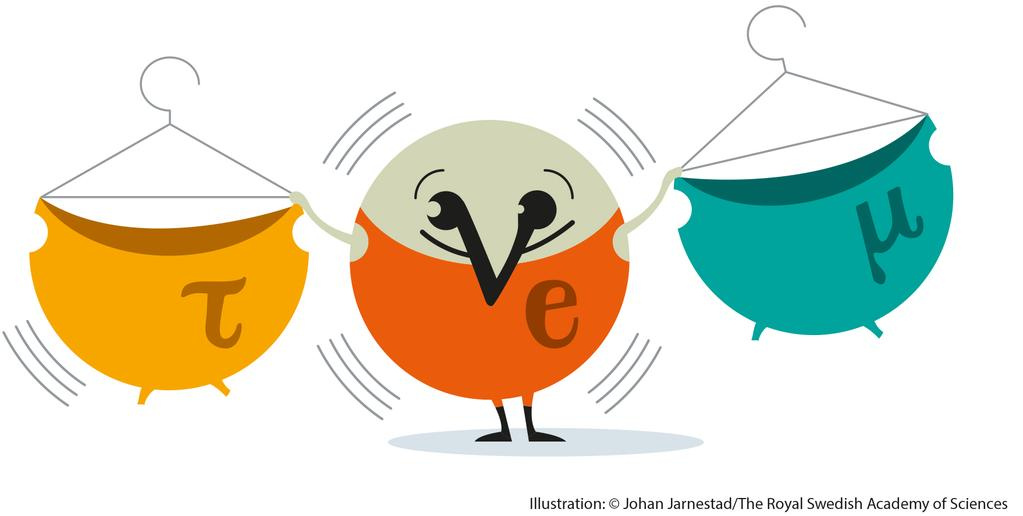
In a previous article I told you how the very idea of the existence of a neutrino appeared in 1932 and how this particle was discovered 25 years later. Let me remind you, Raines and Cowan registered the interaction of antineutrinos with a proton . But even then many scientists believed that there could be several types of neutrinos. Neutrinos actively interacting with an electron were called electron, and neutrinos interacting with a muon , respectively, a muon one. Experimenters needed to figure out whether these two states are different or not. Lederman, Schwartz and Steinberger conducted an outstanding experiment. They investigated the pi-meson beam from the accelerator. Such particles readily decay into muon and neutrino.
If a neutrino really has different grades, then muon must be born. Then everything is simple - we set a target in the path of the born particles and examine how they interact: with the birth of an electron or muon. Experience has clearly shown that electrons are almost not born.
So now we have two types of neutrinos! We are ready to proceed to the next step in the discussion of neutrino oscillations.
In the first neutrino experiments, an artificial source was used: a reactor or an accelerator. This made it possible to create very powerful particle flows, since interactions are extremely rare. But it was much more interesting to register natural neutrinos. Of particular interest is the study of the flow of particles from the sun.
By the middle of the 20th century, it was already clear that firewood was not burning at all in the Sun - they considered it and it turned out that there was not enough firewood. Energy is released during nuclear reactions in the very center of the sun. For example, the main process for our star is called the " proton-proton cycle " when a helium atom is assembled from four protons.

It can be noted that in the first step the particles of interest must be born. And here neutrino physics can show all its power! For optical observation, only the surface of the Sun (the photosphere) is available, and the neutrino freely passes through all the layers of our star. As a result, the registered particles emanate from the center itself, where they are born. We can "observe" directly the core of the sun. Naturally, such studies could not fail to attract physicists. In addition, the expected flow was almost 100 billion particles per square centimeter per second.
The first such experiment put Raymond Davis in America's largest gold mine - Homestake mine. The installation had to be hidden deep underground in order to protect itself from a powerful stream of cosmic particles. Neutrino without problems can pass through one and a half kilometers of rock, but the rest of the particles will be stopped. The detector was a huge barrel filled with 600 tons of tetrachlorethylene - a compound of 4 chlorine atoms. This substance is actively used for dry cleaning and quite cheap.
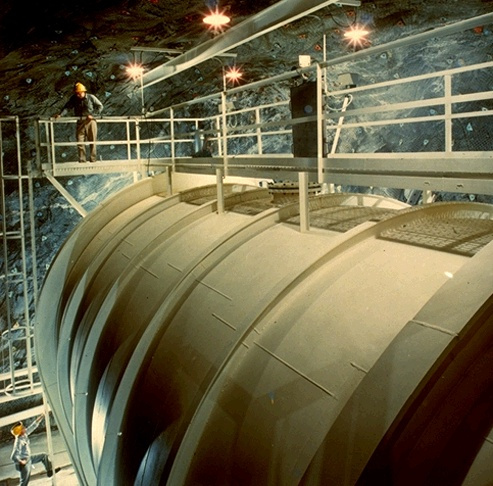
This method of registration suggested Bruno Maximovich Pontecorvo. When interacting with neutrinos, chlorine turns into an unstable argon isotope,
which captures an electron from the lower orbitals and decays back on average over 50 days.
But! Only about 5 neutrino interactions are expected per day. In a couple of weeks, only 70 argon atoms will appear, and they need to be found! Find a few dozen atoms in a 600 ton barrel. A truly fantastic challenge. Once every two months, Davis blew a barrel with helium, blowing out the formed argon. Repeatedly purified gas was placed in a small detector ( Geiger counter ), where the number of decays of argon was considered. So measured the number of neutrino interactions.
Almost immediately it turned out that the neutrino flux from the Sun was almost three times lower than expected, which caused a great sensation in physics. In 2002, Davis, together with Cosiba-san, shared the Nobel Prize for his significant contribution to astrophysics, in terms of the detection of cosmic neutrinos.

A small remark: Davis did not register neutrinos from the proton-proton reaction, which I described above, but from slightly more complex and rare processes with beryllium and boron, but this does not change the essence.
So, the neutrino flux is three times smaller than expected. Why? You can offer the following options:
A year before receiving the results of the Davis experiment, the already mentioned Bruno Pontecorvo is developing a theory of exactly how neutrinos can change their type in a vacuum. One of the consequences is that different types of neutrinos should have different masses. And for what reason are the particles supposed to take and change their mass, which, generally speaking, should be preserved? Let's figure it out.
We cannot do without a small introduction to quantum theory, but I will try to make this explanation as transparent as possible. Only basic geometry is required. The state of the system is described by the “state vector”. Once there is a vector, then there must be a basis. Let's look at the analogy with color space. Our “state” is green. In the RGB basis, we write this vector as (0, 1, 0). But in the CMYK basis, almost the same color will be recorded differently (0.63, 0, 1, 0). Obviously, we have not and cannot have a “main” basis. For different needs: images on the monitor or printing, we must use our coordinate system.
What are the bases for neutrinos? It is logical to decompose the neutrino flux into different types: electronic ( ), muon ( ) and tau ( ). If a stream of exclusively electronic neutrinos flies from the Sun, then this state (1, 0, 0) is in such a basis. But as we have already discussed, neutrinos can be massive. And to have different masses. So you can decompose the neutrino flux and mass states: with masses respectively.
The whole point of the oscillations is that these bases do not coincide! Blue in the picture shows the types (varieties) of neutrinos, and the red state with different masses.

That is, if an electron neutrino appeared in the neutron decay, then three mass states appeared at once (designed on ).
But if these states have slightly different masses, then the energies will be slightly different. And once energies are different, then they will be distributed in space in different ways. The picture shows exactly how these three states will evolve over time.
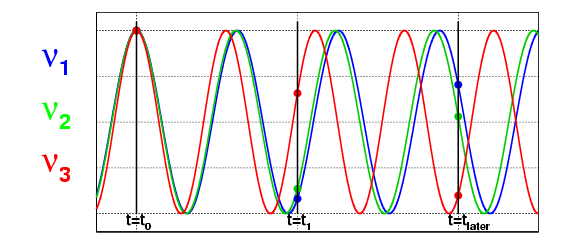
(c) www-hep.physics.wm.edu
In the picture, the motion of a particle is shown as a wave. Such a representation is called the de Broglie wave , or the wave of probability to register a particular particle.
Neutrino interacts depending on the type ( ). Therefore, when we want to calculate how the neutrino will manifest itself, we need to design our state vector on ( ). And so the likelihood of registering a particular type of neutrino is obtained. These are the probability waves we get for the electron neutrino depending on the distance traveled:
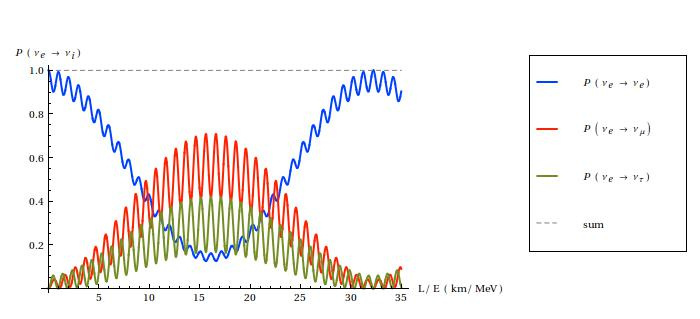
How much the type will change is determined by the relative angles of the described coordinate systems (shown in the previous figure ) and mass differences.
If you are not afraid of the terminology of quantum mechanics, and you have had the patience to finish reading up to this point, then a simple formal description can be found on Wikipedia .
The theory is, of course, good. But so far we can not decide which of the two options is implemented in nature: the Sun is “not that” or the neutrino “is not that”. We need new experiments that will finally show the nature of this interesting effect. Literally in a nutshell I will describe the main installations that have played a key role in the research.
The history of this observatory begins with the fact that here they tried to find the decay of a proton. That is why the detector received the appropriate name - “Kamioka Nucleon” (Kamioka Nucleon Decay Experiment). But finding nothing, the Japanese quickly shifted to a promising direction: the study of atmospheric and solar neutrinos. About that, from where solar come from we have already discussed. Atmospheric ones are born in decays of muons and pi-mesons in the Earth's atmosphere. And while they reach the Earth they manage to oscillate.
The detector began to collect data in 1987. With dates, they were incredibly lucky, but this is the next article :) The installation consisted of a huge barrel filled with pure water. The walls were paved with photomultipliers. The main reaction that caught neutrinos is knocking out an electron from water molecules:
The fast-moving free electron glows in water in dark blue. This radiation was recorded by the photomultiplier on the walls. Subsequently, the installation was upgraded to Super Kamiokande and continued its work.
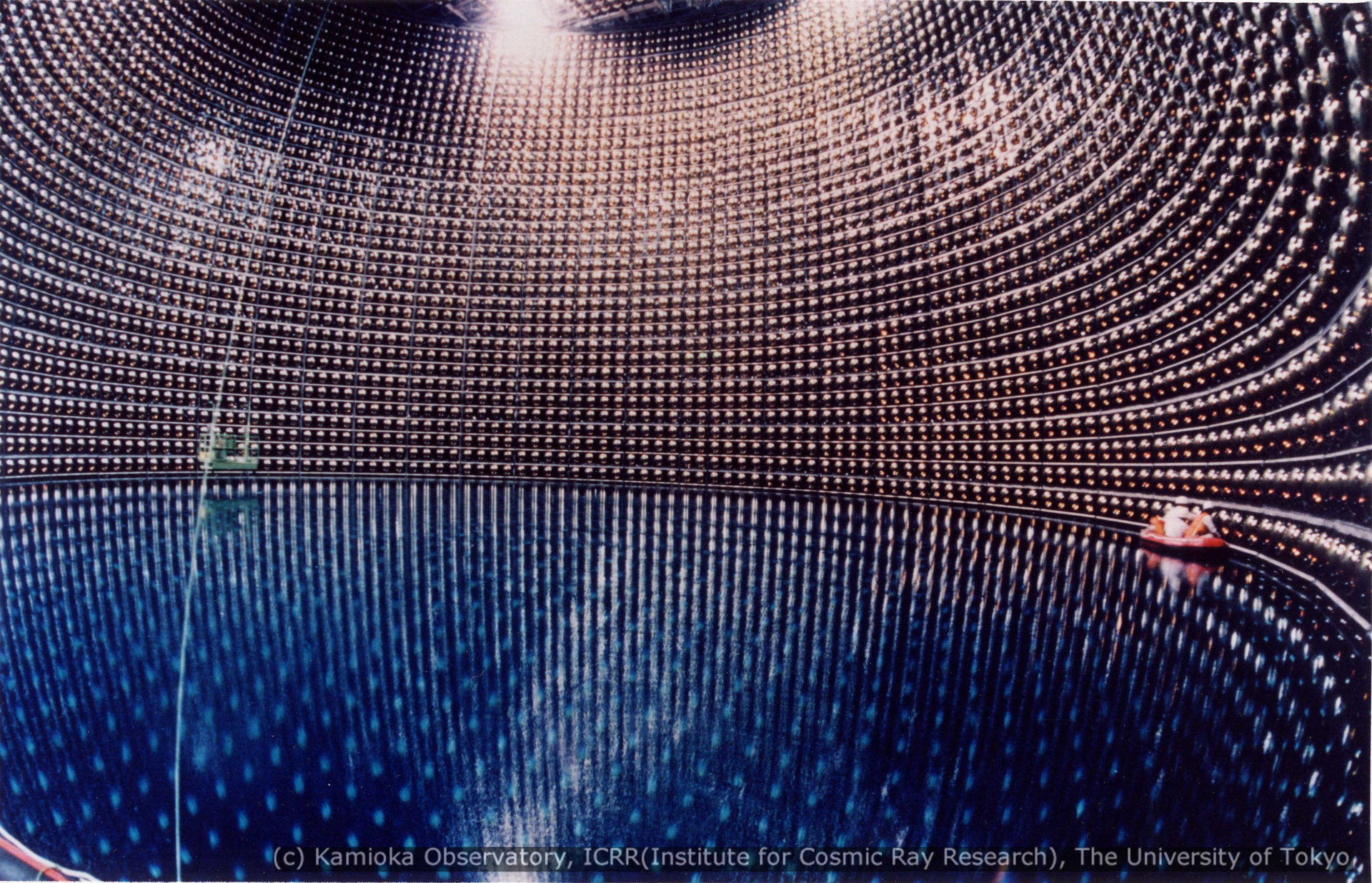
The experiment confirmed the deficit of solar neutrinos and added to this the deficit of atmospheric neutrinos.
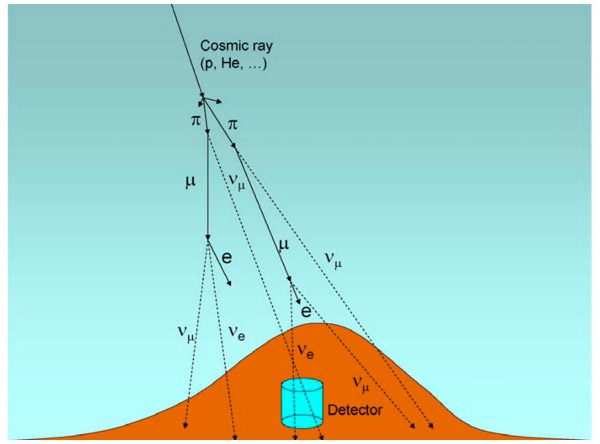
Almost immediately after the launch of Kakiokande in 1990, two gallium detectors began to work. One of them was located in Italy, under the mountain of Grand Sasso in the laboratory of the same name. The second is in the Caucasus, in the Baksan gorge, under the mountain Andyrchi. Neutrino village was built specifically for this laboratory in the gorge. The method itself was proposed by Vadim Kuzmin, inspired by the ideas of Pontecorvo, back in 1964.
When interacting with neutrinos, gallium turns into an unstable germanium isotope, which decays back into gallium on average over 16 days. Within a month, several tens of germanium atoms are formed, which must be very carefully removed from gallium, placed in a small detector and counted back to gallium. The advantage of gallium experiments is that they can catch very low-energy neutrinos that are inaccessible to other installations.
All the above experiments showed that we see fewer neutrinos than expected, but this does not prove the presence of oscillations. The problem may still be in the wrong model of the sun. The SNO experiment put the last and bold point in the solar neutrino problem.
In the mine Craigton Canadians built a huge "death star".
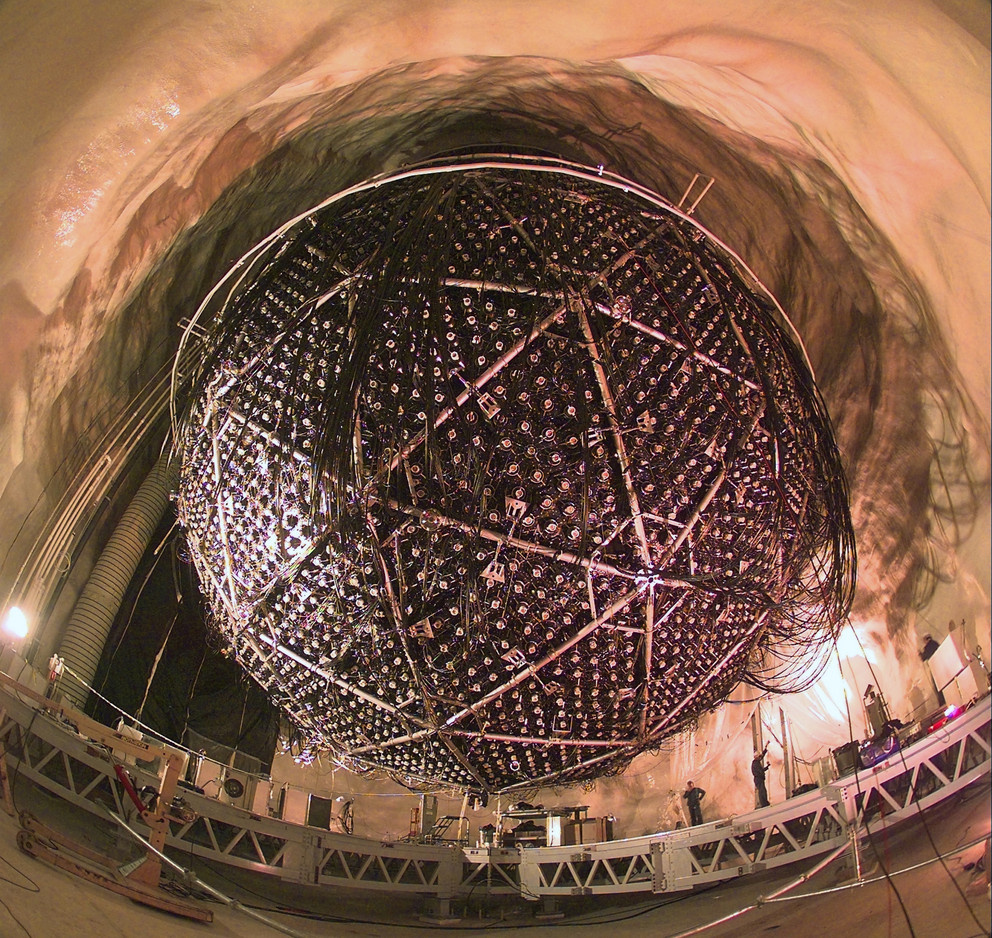
An acrylic sphere surrounded by a photomultiplier and filled with 1000 tons of heavy water was placed at a two-kilometer depth. Such water differs from the usual one in that ordinary hydrogen with one proton is replaced by deuterium - the compound of a proton and a neutron. It was deuterium that played a key role in solving the problems of solar neutrinos. Such a setup could register both the interactions of electron neutrinos and the interactions of all other types! Electronic neutrinos will destroy deuterium with the birth of an electron, while all other types of electrons cannot give birth. But they can slightly "push" the deuterium so that it collapses into its component parts, and the neutrino will fly itself further.
The fast electron, as we have already discussed, glows when moving in a medium, and the neutron must quickly be captured by deuterium, emitting a photon. All this can be registered using photomultipliers. Physicists finally got the opportunity to measure the total flow of particles from the sun. If it turns out that it coincides with the expectations, then the electron neutrinos are transformed into others, and if it is less than expected, then the wrong model of the Sun is to blame.
The experiment began in 1999, and measurements confidently indicated that there is a shortage of the electronic component.
Let me remind you that an electron neutrino can be born almost exclusively in a star. So the rest turned out in the process of oscillation! Arthur MacDonald (SNO) and Kajita-san (Kamiokande) received the 2015 Nobel Prize for this work.
Almost immediately, at the beginning of the 2000s, other experiments began to study oscillations. This effect was also observed for man-made neutrinos. The Japanese experiment KamLAND, located in the same place, in Kamioka, already in 2002, observed oscillations of electron antineutrinos from the reactor. And the second, also Japanese, experiment K2K for the first time registered a change in the type of neutrinos created using an accelerator. The well-known Super-Kamiokande was used as a long-range detector.
Now more and more installations are investigating this effect. Detectors are being built at Baikal, in the Mediterranean Sea, at the South Pole. There were installations near the North Pole. They all catch neutrinos of cosmic origin. Accelerator and reactor experiments work. The parameters of the oscillations themselves are refined, attempts are made to learn something about the magnitude of the neutrino masses. There are indications that it is with this effect that the prevalence of matter over antimatter in our Universe can be explained!
I want to note that they change their flavors and quarks in the same way, only this effect is much weaker for them.
PS I continue to try feathers in popular articles, so I would appreciate feedback / comments / inquiries. As I find the time, next time I plan to write how the astrophysical object was first observed not through electromagnetic radiation.
Spoiler - with the help of neutrinos :)


Another neutrino
In a previous article I told you how the very idea of the existence of a neutrino appeared in 1932 and how this particle was discovered 25 years later. Let me remind you, Raines and Cowan registered the interaction of antineutrinos with a proton . But even then many scientists believed that there could be several types of neutrinos. Neutrinos actively interacting with an electron were called electron, and neutrinos interacting with a muon , respectively, a muon one. Experimenters needed to figure out whether these two states are different or not. Lederman, Schwartz and Steinberger conducted an outstanding experiment. They investigated the pi-meson beam from the accelerator. Such particles readily decay into muon and neutrino.
If a neutrino really has different grades, then muon must be born. Then everything is simple - we set a target in the path of the born particles and examine how they interact: with the birth of an electron or muon. Experience has clearly shown that electrons are almost not born.
So now we have two types of neutrinos! We are ready to proceed to the next step in the discussion of neutrino oscillations.
This is some kind of "wrong" Sun
In the first neutrino experiments, an artificial source was used: a reactor or an accelerator. This made it possible to create very powerful particle flows, since interactions are extremely rare. But it was much more interesting to register natural neutrinos. Of particular interest is the study of the flow of particles from the sun.
By the middle of the 20th century, it was already clear that firewood was not burning at all in the Sun - they considered it and it turned out that there was not enough firewood. Energy is released during nuclear reactions in the very center of the sun. For example, the main process for our star is called the " proton-proton cycle " when a helium atom is assembled from four protons.

It can be noted that in the first step the particles of interest must be born. And here neutrino physics can show all its power! For optical observation, only the surface of the Sun (the photosphere) is available, and the neutrino freely passes through all the layers of our star. As a result, the registered particles emanate from the center itself, where they are born. We can "observe" directly the core of the sun. Naturally, such studies could not fail to attract physicists. In addition, the expected flow was almost 100 billion particles per square centimeter per second.
The first such experiment put Raymond Davis in America's largest gold mine - Homestake mine. The installation had to be hidden deep underground in order to protect itself from a powerful stream of cosmic particles. Neutrino without problems can pass through one and a half kilometers of rock, but the rest of the particles will be stopped. The detector was a huge barrel filled with 600 tons of tetrachlorethylene - a compound of 4 chlorine atoms. This substance is actively used for dry cleaning and quite cheap.

This method of registration suggested Bruno Maximovich Pontecorvo. When interacting with neutrinos, chlorine turns into an unstable argon isotope,
which captures an electron from the lower orbitals and decays back on average over 50 days.
But! Only about 5 neutrino interactions are expected per day. In a couple of weeks, only 70 argon atoms will appear, and they need to be found! Find a few dozen atoms in a 600 ton barrel. A truly fantastic challenge. Once every two months, Davis blew a barrel with helium, blowing out the formed argon. Repeatedly purified gas was placed in a small detector ( Geiger counter ), where the number of decays of argon was considered. So measured the number of neutrino interactions.
Almost immediately it turned out that the neutrino flux from the Sun was almost three times lower than expected, which caused a great sensation in physics. In 2002, Davis, together with Cosiba-san, shared the Nobel Prize for his significant contribution to astrophysics, in terms of the detection of cosmic neutrinos.

A small remark: Davis did not register neutrinos from the proton-proton reaction, which I described above, but from slightly more complex and rare processes with beryllium and boron, but this does not change the essence.
Who is to blame and what to do?
So, the neutrino flux is three times smaller than expected. Why? You can offer the following options:
- Sun model is incorrect. Despite long-term optical observations, we absolutely do not understand how the sun works. The total neutrino flux is less than expected;
- Something is wrong with the neutrinos themselves. For example, they change type on the way to Earth ( ) and can no longer interact with the birth of an electron. General flow not changed.
These non-constant neutrinos
A year before receiving the results of the Davis experiment, the already mentioned Bruno Pontecorvo is developing a theory of exactly how neutrinos can change their type in a vacuum. One of the consequences is that different types of neutrinos should have different masses. And for what reason are the particles supposed to take and change their mass, which, generally speaking, should be preserved? Let's figure it out.
We cannot do without a small introduction to quantum theory, but I will try to make this explanation as transparent as possible. Only basic geometry is required. The state of the system is described by the “state vector”. Once there is a vector, then there must be a basis. Let's look at the analogy with color space. Our “state” is green. In the RGB basis, we write this vector as (0, 1, 0). But in the CMYK basis, almost the same color will be recorded differently (0.63, 0, 1, 0). Obviously, we have not and cannot have a “main” basis. For different needs: images on the monitor or printing, we must use our coordinate system.
What are the bases for neutrinos? It is logical to decompose the neutrino flux into different types: electronic ( ), muon ( ) and tau ( ). If a stream of exclusively electronic neutrinos flies from the Sun, then this state (1, 0, 0) is in such a basis. But as we have already discussed, neutrinos can be massive. And to have different masses. So you can decompose the neutrino flux and mass states: with masses respectively.
The whole point of the oscillations is that these bases do not coincide! Blue in the picture shows the types (varieties) of neutrinos, and the red state with different masses.

That is, if an electron neutrino appeared in the neutron decay, then three mass states appeared at once (designed on ).
But if these states have slightly different masses, then the energies will be slightly different. And once energies are different, then they will be distributed in space in different ways. The picture shows exactly how these three states will evolve over time.

(c) www-hep.physics.wm.edu
In the picture, the motion of a particle is shown as a wave. Such a representation is called the de Broglie wave , or the wave of probability to register a particular particle.
Neutrino interacts depending on the type ( ). Therefore, when we want to calculate how the neutrino will manifest itself, we need to design our state vector on ( ). And so the likelihood of registering a particular type of neutrino is obtained. These are the probability waves we get for the electron neutrino depending on the distance traveled:

How much the type will change is determined by the relative angles of the described coordinate systems (shown in the previous figure ) and mass differences.
If you are not afraid of the terminology of quantum mechanics, and you have had the patience to finish reading up to this point, then a simple formal description can be found on Wikipedia .
And how really?
The theory is, of course, good. But so far we can not decide which of the two options is implemented in nature: the Sun is “not that” or the neutrino “is not that”. We need new experiments that will finally show the nature of this interesting effect. Literally in a nutshell I will describe the main installations that have played a key role in the research.
Kamioka Observatory
The history of this observatory begins with the fact that here they tried to find the decay of a proton. That is why the detector received the appropriate name - “Kamioka Nucleon” (Kamioka Nucleon Decay Experiment). But finding nothing, the Japanese quickly shifted to a promising direction: the study of atmospheric and solar neutrinos. About that, from where solar come from we have already discussed. Atmospheric ones are born in decays of muons and pi-mesons in the Earth's atmosphere. And while they reach the Earth they manage to oscillate.
The detector began to collect data in 1987. With dates, they were incredibly lucky, but this is the next article :) The installation consisted of a huge barrel filled with pure water. The walls were paved with photomultipliers. The main reaction that caught neutrinos is knocking out an electron from water molecules:
The fast-moving free electron glows in water in dark blue. This radiation was recorded by the photomultiplier on the walls. Subsequently, the installation was upgraded to Super Kamiokande and continued its work.

The experiment confirmed the deficit of solar neutrinos and added to this the deficit of atmospheric neutrinos.

Gallium experiments
Almost immediately after the launch of Kakiokande in 1990, two gallium detectors began to work. One of them was located in Italy, under the mountain of Grand Sasso in the laboratory of the same name. The second is in the Caucasus, in the Baksan gorge, under the mountain Andyrchi. Neutrino village was built specifically for this laboratory in the gorge. The method itself was proposed by Vadim Kuzmin, inspired by the ideas of Pontecorvo, back in 1964.
When interacting with neutrinos, gallium turns into an unstable germanium isotope, which decays back into gallium on average over 16 days. Within a month, several tens of germanium atoms are formed, which must be very carefully removed from gallium, placed in a small detector and counted back to gallium. The advantage of gallium experiments is that they can catch very low-energy neutrinos that are inaccessible to other installations.
All the above experiments showed that we see fewer neutrinos than expected, but this does not prove the presence of oscillations. The problem may still be in the wrong model of the sun. The SNO experiment put the last and bold point in the solar neutrino problem.
Sudbury Observatory
In the mine Craigton Canadians built a huge "death star".

An acrylic sphere surrounded by a photomultiplier and filled with 1000 tons of heavy water was placed at a two-kilometer depth. Such water differs from the usual one in that ordinary hydrogen with one proton is replaced by deuterium - the compound of a proton and a neutron. It was deuterium that played a key role in solving the problems of solar neutrinos. Such a setup could register both the interactions of electron neutrinos and the interactions of all other types! Electronic neutrinos will destroy deuterium with the birth of an electron, while all other types of electrons cannot give birth. But they can slightly "push" the deuterium so that it collapses into its component parts, and the neutrino will fly itself further.
The fast electron, as we have already discussed, glows when moving in a medium, and the neutron must quickly be captured by deuterium, emitting a photon. All this can be registered using photomultipliers. Physicists finally got the opportunity to measure the total flow of particles from the sun. If it turns out that it coincides with the expectations, then the electron neutrinos are transformed into others, and if it is less than expected, then the wrong model of the Sun is to blame.
The experiment began in 1999, and measurements confidently indicated that there is a shortage of the electronic component.
Let me remind you that an electron neutrino can be born almost exclusively in a star. So the rest turned out in the process of oscillation! Arthur MacDonald (SNO) and Kajita-san (Kamiokande) received the 2015 Nobel Prize for this work.
Almost immediately, at the beginning of the 2000s, other experiments began to study oscillations. This effect was also observed for man-made neutrinos. The Japanese experiment KamLAND, located in the same place, in Kamioka, already in 2002, observed oscillations of electron antineutrinos from the reactor. And the second, also Japanese, experiment K2K for the first time registered a change in the type of neutrinos created using an accelerator. The well-known Super-Kamiokande was used as a long-range detector.
Now more and more installations are investigating this effect. Detectors are being built at Baikal, in the Mediterranean Sea, at the South Pole. There were installations near the North Pole. They all catch neutrinos of cosmic origin. Accelerator and reactor experiments work. The parameters of the oscillations themselves are refined, attempts are made to learn something about the magnitude of the neutrino masses. There are indications that it is with this effect that the prevalence of matter over antimatter in our Universe can be explained!
Under the spoiler is a small note for the most thoughtful.
The 2015 award was given out with the wording “for the discovery of neutrino oscillations, showing their mass”. In the circle of physicists, this statement caused some confusion . When measuring solar neutrinos (SNO experiment), we are insensitive to mass differences. Generally speaking, the mass may be zero, and the oscillations will remain. This behavior is explained by the interaction of neutrinos with the Sun's matter ( the Mikheev-Smirnov-Wolfenstein effect ). That is, there are oscillations of solar neutrinos, their discovery is a fundamental breakthrough, but this has never indicated the presence of mass. In fact, the Nobel Committee issued the award with incorrect wording.
Oscillations in vacuum manifest themselves for atmospheric, reactor and accelerator experiments.
Oscillations in vacuum manifest themselves for atmospheric, reactor and accelerator experiments.
I want to note that they change their flavors and quarks in the same way, only this effect is much weaker for them.
PS I continue to try feathers in popular articles, so I would appreciate feedback / comments / inquiries. As I find the time, next time I plan to write how the astrophysical object was first observed not through electromagnetic radiation.
Spoiler - with the help of neutrinos :)

All Articles